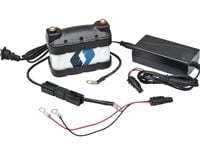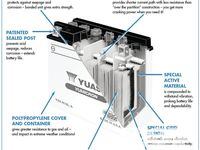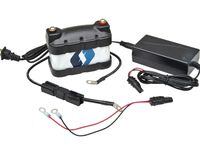I saw in the May issue that you are testing the Antigravity lithium-iron Battery in the Yamaha R1. I also saw, on the next page, the Shorai LFX lithium-iron Battery. I am not familiar with the qualities of the lithium-iron. However, lithium-ion batteries can and do catch fire if they get to thermal overrun. In brief, if the lithium-ion gets to about 350 degrees Fahrenheit, it will run away. Many bike batteries are housed near hot exhaust. It would not be unreasonable for a battery — given internal heat from charging, a hot day or being stuck in traffic — to reach this temperature. I was wondering if there is some characteristic of the Li-Fe battery that would prevent a thermal runaway? Saving weight is great — but not if the ride catches fire.
** _Tim Berridge**_
A lithium-iron battery is a particular type of lithium-ion battery, and does not have the same problems with thermal overrun as the lithium-ion batteries found in laptops and other consumer devices sometimes do. To understand the difference, it helps to know some battery chemistry first. A typical battery has three basic components: The anode, the cathode and the electrolyte. The anode and cathode are the two terminals of the battery, and they are immersed in the electrolyte. The chemical reaction between the materials causes electrons to go back and forth between the anode and cathode as the battery charges and discharges. A typical car or motorcycle battery is a lead-acid type, with the most common construction being a lead anode and lead-dioxide cathode, while the electrolyte is a sulfuric acid solution.
A lithium-ion battery has a lithium-based cathode and carbon/graphite anode in a lithium-based solvent acting as the electrolyte. As the battery charges and discharges, lithium ions — atoms with a positive charge — rather than electrons move back and forth between the anode and cathode. The name, in this case, comes from the process and not the material used in the anode or cathode. The lithium-ion batteries in laptops have a cathode made from a lithium-cobalt oxide, and it is this material that causes the thermal overrun in rare cases. Lithium-iron batteries, on the other hand, get their name from the material and not the process, using a lithium iron phosphate for the cathode. These batteries are also sometimes referred to by the lithium iron phosphate molecular formula: LiFePO4. A lithium-iron battery offers less performance than the lithium-cobalt type, especially when both are new; however, the lithium-iron battery is more chemically stable and less sensitive to temperature extremes.
We tested a lightweight aftermarket batteries from Shorai (www.shoraipower.com) in our last issue, and are currently testing batteries from Anitgravity (www.antigravitybatteries.com) and Full Spectrum Power (www.fullspectrumpower.com). All three utilize lithium-iron technology, and your bike would have no more chance of catching fire on a hot day than it would using a standard battery.
Got a question?
The Geek
831 S. Douglas St.,
El Segundo, CA 90245
or e-mail srmail@sorc.com



/cloudfront-us-east-1.images.arcpublishing.com/octane/A4EN3OE2HRBXVFICJ6K62CNXCM.jpg)
/cloudfront-us-east-1.images.arcpublishing.com/octane/ZBLIY3XNQ5ACNNJ65IL44KBZAE.jpg)
/cloudfront-us-east-1.images.arcpublishing.com/octane/HDO56KGQB5H25DJRM2J2PH2E5A.jpg)
/cloudfront-us-east-1.images.arcpublishing.com/octane/NZKPFUWBHVGYJAFQPCXWAK6BZM.jpg)
/cloudfront-us-east-1.images.arcpublishing.com/octane/K5ZSQFMYQZHWRFXTTW4PEWMUDM.jpg)
/cloudfront-us-east-1.images.arcpublishing.com/octane/D2SOSBIQQRBPTERNSOJRAW3KYY.jpg)
/cloudfront-us-east-1.images.arcpublishing.com/octane/DS3Q5X2VJFFAJDK2PWB3Y7K6U4.jpg)
/cloudfront-us-east-1.images.arcpublishing.com/octane/4KBL4JAMYRFDPEINTWATDUH7OM.jpg)
/cloudfront-us-east-1.images.arcpublishing.com/octane/FXADK3MVSNBRTKJ2B7TPDCCJ5Y.jpg)
/cloudfront-us-east-1.images.arcpublishing.com/octane/M7L2CPXO55FRFMECW7QGDPGP6E.jpg)
/cloudfront-us-east-1.images.arcpublishing.com/octane/T4RWGLAEHVE2VCJZOTFTNGB2KA.jpg)
/cloudfront-us-east-1.images.arcpublishing.com/octane/JM4QGLAHWNGHPM74OEB7FVBFSY.jpg)
/cloudfront-us-east-1.images.arcpublishing.com/octane/BGPNXPDDYBHD3HL6YEZQOYHXTI.jpg)
/cloudfront-us-east-1.images.arcpublishing.com/octane/SND5GGQV4RDPPMZBSBEGIZ4SIY.jpg)
/cloudfront-us-east-1.images.arcpublishing.com/octane/XUDDAPYZMZEL5EDPVDJ2DTULWI.jpg)
/cloudfront-us-east-1.images.arcpublishing.com/octane/M7AU2L6GAVCJVHW57LIRPDAAUQ.jpg)

/cloudfront-us-east-1.images.arcpublishing.com/octane/JKEJY7P43JGD5C5NJO2VJQJPUM.jpg)
/cloudfront-us-east-1.images.arcpublishing.com/octane/YROKYJYUQVGPHCEMPTGBWDQCKQ.jpg)
/cloudfront-us-east-1.images.arcpublishing.com/octane/QIHEYR66TZDAPCGMWHCWCBC4XA.jpg)
/cloudfront-us-east-1.images.arcpublishing.com/octane/4FTBMNZL5BD2ZHY62XXRHJW6PI.jpg)
/cloudfront-us-east-1.images.arcpublishing.com/octane/L2BHKRCEMFDF7O3S4REZXPDH2E.jpg)
/cloudfront-us-east-1.images.arcpublishing.com/octane/QHENIV3HMJCTTCXQ6O5YPTNRZ4.jpg)
/cloudfront-us-east-1.images.arcpublishing.com/octane/K3VNQBIAKVGIHIGBRG7QKJYLVI.jpg)